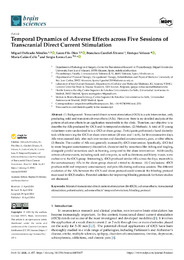Title:
Temporal Dynamics of Adverse Effects across Five Sessions of Transcranial Direct Current Stimulation |
Authors:
Delicado Miralles, Miguel 
Flix Díez, Laura 
Gurdiel-Álvarez, Francisco 
Velasco, Enrique
Galán-Calle, María
Lerma Lara, Sergio  |
Editor:
MDPI |
Department:
Departamentos de la UMH::Patología y Cirugía |
Issue Date:
2024-04-30 |
URI:
https://hdl.handle.net/11000/34180 |
Abstract:
Background: Transcranial direct current stimulation (tDCS) is a safe intervention, only
producing mild and transient adverse effects (AEs). However, there is no detailed analysis of the
pattern of adverse effects in an application transferable to the clinic. Therefore, our objective is to
describe the AEs produced by tDCS and its temporal evolution. (2) Methods: A total of 33 young
volunteers were randomized into a tDCS or sham group. Participants performed a hand dexterity
task while receiving the tDCS or sham intervention (20 min and 1 mA), for five consecutive days.
AEs were assessed daily after each intervention and classified as somatosensory, pain, or other effects.
(3) Results: The number of AEs was generally increased by tDCS intervention. Specifically, tDCS led
to more frequent somatosensory discomfort, characterized by sensations like itching and tingling,
alongside painful sensations such as burning, compared to the sham intervention. Additionally,
certain adverse events, including neck and arm pain, as well as dizziness and blurry vision, were
exclusive to the tDCS group. Interestingly, tDCS produced similar AEs across the days; meanwhile,
the somatosensory AEs in the sham group showed a trend to decrease. (4) Conclusions: tDCS
produces mild and temporary somatosensory and pain AEs during and across sessions. The different
evolution of the AEs between the tDCS and sham protocol could unmask the blinding protocol
most used in tDCS studies. Potential solutions for improving blinding protocols for future studies
are discussed.
|
Keywords/Subjects:
bilateral transcranial direct current stimulation (bi-tDCS)
adverse effects
transcranial stimulation
patient safety
adverse effects’ temporal evolution
blinding protocol |
Type of document:
info:eu-repo/semantics/article |
Access rights:
info:eu-repo/semantics/openAccess
Attribution-NonCommercial-NoDerivatives 4.0 Internacional |
Published in:
Brain Sciences. 2024, 14, 457 |
Appears in Collections:
Artículos Patología y Cirugía
|

.png)
